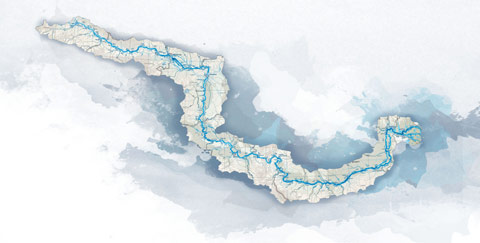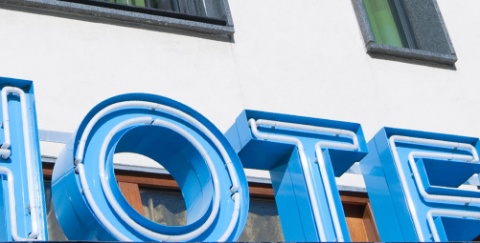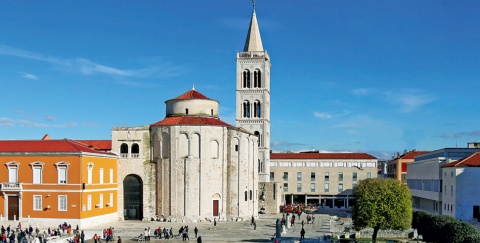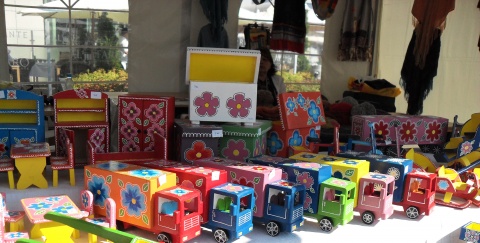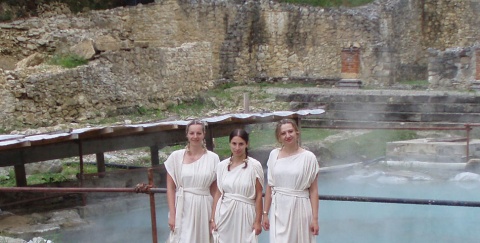
Pula (population: 57,800), the largest city on the Istria peninsula, was named after Histri, a Venetic or an Illyrian tribe, who settled here before Roman conquest in 177 BC. Shortly before Gaius Julius Caesar was assassinated, Pola, as Romans named it (Greek: Polai), officially became a colony 46/45 BC. With a population of over 30,000, it has since been the centre of wine production, fishing and shipbuilding and a major port for all economic and military traffic to the Roman provinces along the Lower Danube. Unfortunately, in 42 BC, during the civil war of the triumvirate of Octavian, Mark Antony and Lepidus against the assassins of Julius Caesar, Pula supported Brutus and Cassius, and because of it was demolished after Octavian’s victory. Pula’s Arch of the Sergii, a triumphal arch built in 29–27 BC by the powerful local Sergii family, commemorates three brothers of the Sergii family, specifically Lucius Sergius Lepidus who served as a tribune in 29th legion and participated in the Battle of Actium (31 BC) that made Octavian the first Roman emperor Augustus. Many artists, including the great Michelangelo Buonarotti, have admired its beauty.
Iulia, the daughter of Augustus, convinced the emperor to rebuild the city as Colonia Pietas Iulia Pola Pollentia Herculanea. The Pula Arena, the city’s great amphitheatre (27 BC–68 AD) is one of the six largest surviving Roman arenas in the world. Built a little before the famous Coliseum in Rome, it was situated 200 metres outside the city walls and was a site of gladiator duels (until early 5th century, when they were banned) and animal slayings that took place before 23,000 enthusiastic spectators. It covers 11,466 m2, the axes of the elliptical amphitheatre are 132.45 and 105.10 metres long, and the walls stand 32.45 metres high. In medieval times, fairs and knight tournaments took place here, and it is the venue for open-air summer performances.In the subterranean section of the amphitheatre, the exhibition Viticulture and Olive Oil Production in Istria during the Roman Period shows the great importance of top quality olive oil and wine since the Roman times.
Emperor Augustus himself is honoured with the Temple of Rome and Augustus, built between 2 BC and 14 AD. Originally a part of a complex of three temples standing at the left side of the central temple, this building with Corinthian columns later became a Byzantine church and then a granary. Bombed and damaged in 1944 and reconstructed in 1947, it serves today as a lapidarium for Roman sculpture.
While nothing has left of the central temple, parts of the temple dedicated to Goddess Diana were integrated into Pula’s medieval Communal Palace, built in 1296 on the main town square, where Augustan Forum used to stand. The Cathedral of the Assumption of the Blessed Virgin Mary was built on the site where the Temple of Jupiter used to be, and where first Christians used to gather and play in the Roman times. The first Christian churches were built here in the late 4th and early 5th century AD. Ancient Pola was fortified and walled. It had ten city gates including the Gate of Hercules (1st century AD) and the Twin Gates (Porta Gemina) from mid-2nd century AD. The importance of the city is also indicated by its two Roman theatres. Stroll down the narrow alleys of the attractive old city quarter and its medieval and Renaissance buildings. Explore the Byzantine chapel St Mary Formosa (6th century AD) and the castle with four bastions on the top of the central city hill. Check out the reconstructed Church of the Sacred Heart of Jesus and Mary, now used as a museum, a gallery and a concert venue. Visit the famous Aquarium, the biggest one in Croatia, the Historical and Maritime Museum of Istria, the Museum of Contemporary Art of Istria, café-bar Kunstkafe Cvajner on Forum 2,and Pula’s latest attraction – the Austro-Hungarian underground galleries Zerostrasse on Carrarina 3, near the Twin Gates. Do not miss the Archaeological Museum of Istria and the Archaeological Park of Nesactium if you are interested in the Late Roman period.
One of the best preserved of once richly decorated Roman villas near Pula is the villa rustica (1st century BC) on the island of Veli Brijun. It belonged to the Laecanius family and consisted of several buildings stretching down the bay of Verige for a kilometre and connected by promenades. Veli Brijun is part of the Brijuni Archipelago and the National Park Brijuni. It is a home to many animal and plant species It has a rich submarine world (with an underwater trail!). Take a tourist train and explore the villa and the zebras, Somali sheep, zebus, elephants and llamas in the safari park. You will also see a summer residence with the infrastructure for oil production, three temples, an antique home gym, baths and a fish pond.
Check out the historical jewels of the archipelago covering an area of 7 km² including Illyrian forts, Neolithic settlements and excavations in Soline Bay. Visit the resting place of Paul Kupelwieser, an Austrian industrialist who bought the whole archipelago to transform it to an exclusive summer resort. Imagine what Belvedere Ciprovac used to be like. It used to be a health resort in the early 20th century and one of many presidential residencies of Josip Broz Tito (1892–1980). Five thousand years of history and the outstanding beauty of the islands make it an unforgettable experience. Brijuni (Italian: Brioni), is also a familiar name in the fashion world – men’s fashion brand Brioni, based in Rome, was named after the islands as its owner is originally from here.
DANUBE.TRAVEL has no control over the website content generated by users and/or visitors, neither such content represents a statement, opinion, recommendation or rating by DANUBE.TRAVEL. For further information please refer to DANUBE.TRAVEL – General Website Terms and Conditions of Use.
 EN
EN DE
DE
